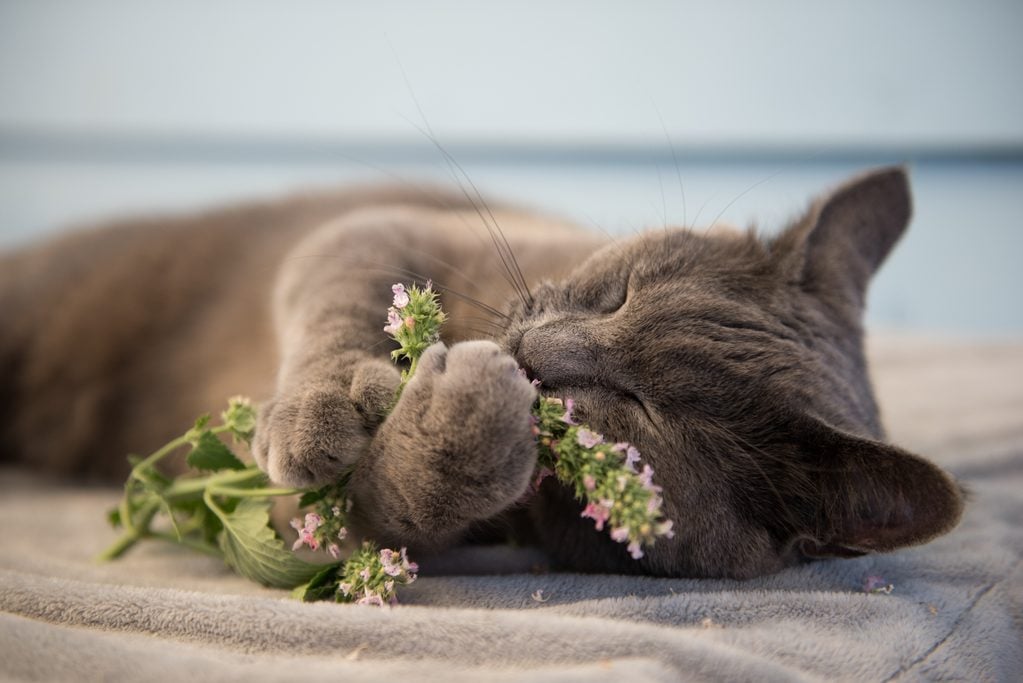What Does Catnip Do to Cats?
Updated: Nov. 28, 2022

Does catnip really get your cat high? Here's what catnip does to cats—and why they go crazy for it.
If you’re lucky enough to be a cat owner, you know that cat behavior is basically a spectrum of weird quirks and strange noises. If your kitty likes a catnip treat now and then, you’ve probably wondered: what exactly does catnip do to cats? You may be able to answer questions like why do cats purr, or why do cats sleep so much, or even know exactly why cats meow. But after just one sniff (or chomp!) of a catnip plant, many cats start acting in truly bizarre ways. Entertainment value aside, this herb has proven benefits for felines—but that still leaves us wondering what exactly the effect is on our furry friends.
What is catnip?
Nepeta cataria, the scientific name for catnip, is an herb in the mint family that can grow up to three feet high. Indigenous to Europe, it was transplanted to North America during European settlement. But it isn’t the only herb known to get your kitty to boogie. A study suggests that valerian root, silver vine, and Tatarian honeysuckle can also have a similar effect to catnip on cats’ behavior; if your cat isn’t a fan of catnip, you can give these alternatives a try. All these herbs are safe for cats to ingest in small amounts, but there are some mistakes cat owners should never make.
So what does catnip do to cats?
Cats like catnip for two reasons: smelling it stimulates their senses, and eating it calms them down. Felines are receptive to a volatile oil (an oil that evaporates in the air) found in the stems and leaves of the catnip herb. When they get a whiff of catnip, they behave similarly to female cats in heat (although male cats can experience the effects too)—erratic movements, strange howls, and all. Many cats react to catnip by rolling around, flipping over, rubbing on everything, and eventually zoning out. This out-of-fur experience is due to the active ingredient in the oil, nepetalactone. It binds to receptors inside the cat’s nose and drives its sensory neurons crazy, according to Daniel Rotman, CEO of PrettyLitter.
However, when a cat eats the herb, it has a calming effect. “If the catnip is ingested, it causes fatigue and works as a sedative. For cats that sniff catnip and rub against the plants, they’ll get more of the stimulating effects,” Rotman said. “Both smelling and ingesting catnip is safe for your feline family member.” Our furry pals can’t survive on catnip treats alone—the best dry foods for cats will hold them over.
How long does it last?
Catnip’s effects on your cat will only last a short time—about 5 to 30 minutes, says Rotman. This is all dependent on your individual kitty, because studies show that only two-thirds of adult felines are affected by the herb. “About 50 percent of cats seem to be affected by catnip, and the behavior that results varies widely between individuals,” Rotman says. “[This] is an inherited sensitivity and it doesn’t show up immediately. Instead, it will take a few months since young kittens are not affected.” If you think kitty might enjoy a catnip nap (or a catnip boogie around the room), you can make your own catnip crackers for your cat to enjoy.
What are the benefits?
If you have an indoor-only cat, you probably worry about them being under-stimulated. After all, you can’t be around to play with them every moment they’re awake. Studies show that cats, like all animals, need mental and physical exercise to be happy, and an interesting experience like sniffing or eating catnip could be part of that enrichment. Kitties that don’t receive enough stimulation could develop aggressive, depressed, or anxious behavior—watch out for these silent signs your cat is depressed.
Just make sure you don’t give your cat too much catnip, as it can lead to dizziness or vomiting. Once a week is fine, a little at a time. Fresh is more potent than dried, and catnip sprays can be used on a favorite toy or scratching post if your kitty gets an upset stomach from eating it.
Does catnip make cats high?
Although catnip may seem like a drug, Rotman confirms that it’s not addictive for cats. He does mention that catnip sometimes makes cats aggressive, though. “If you have a multi-cat household, it’s recommended to introduce catnip to each cat individually to avoid any potential fighting,” Rotman says. Now that you know how catnip affects your feline friend, you’ll want to learn why cats eat grass, too.
Sources:
- USDA.gov: “Plants”
- Scientific American: “How Does Catnip Work Its Magic on Cats?”
- BMC Veterinary Research: “Responsiveness of Cats”
- Daniel Rotman, CEO of PrettyLitter
- Behavioural Processes Journal: “Active and Passive Responses to Catnip”



